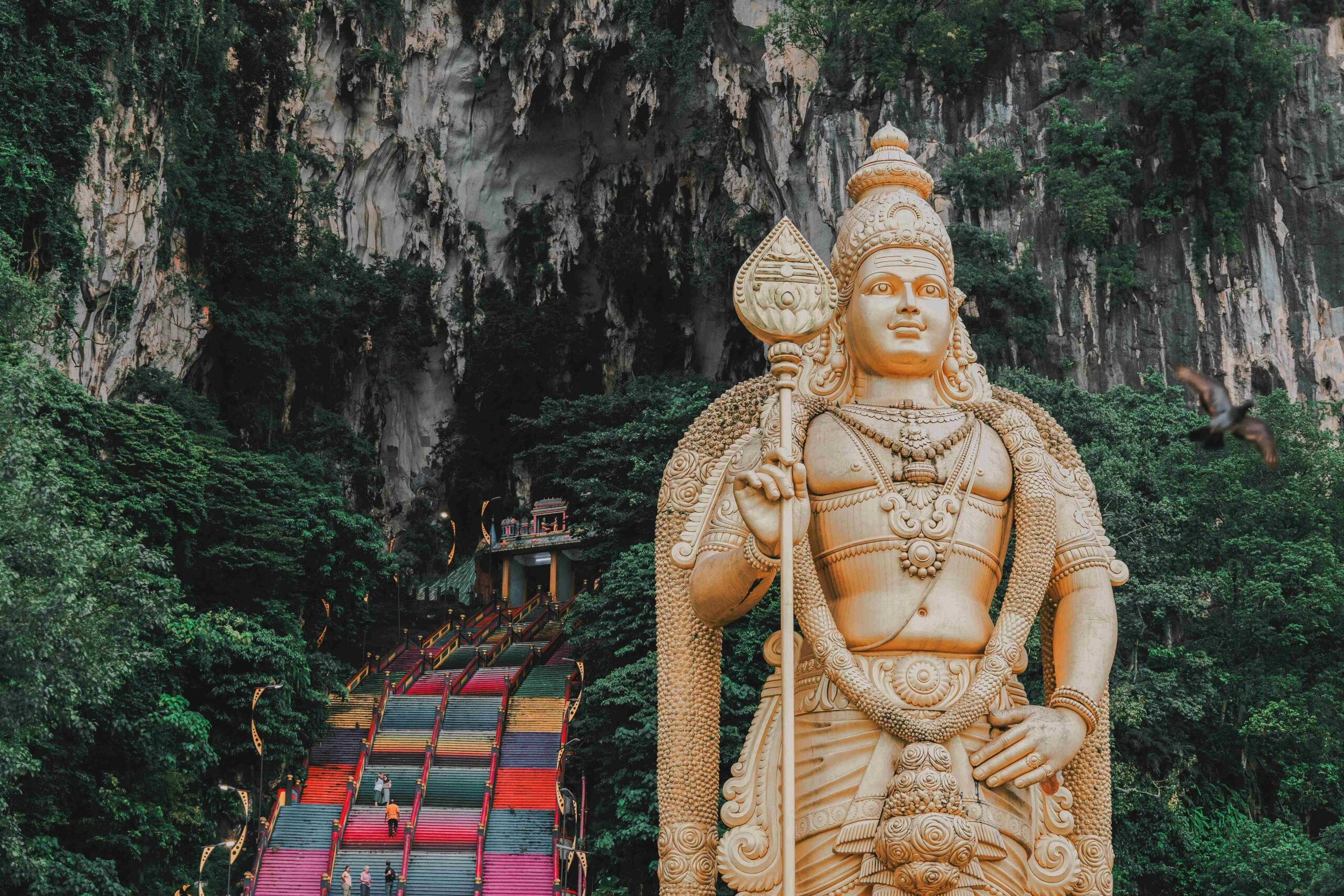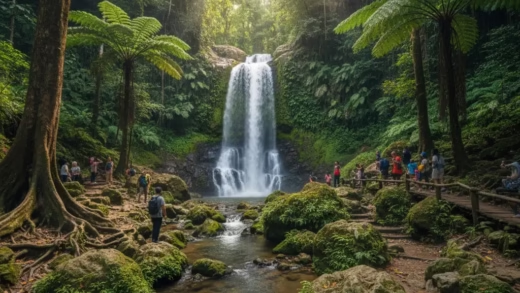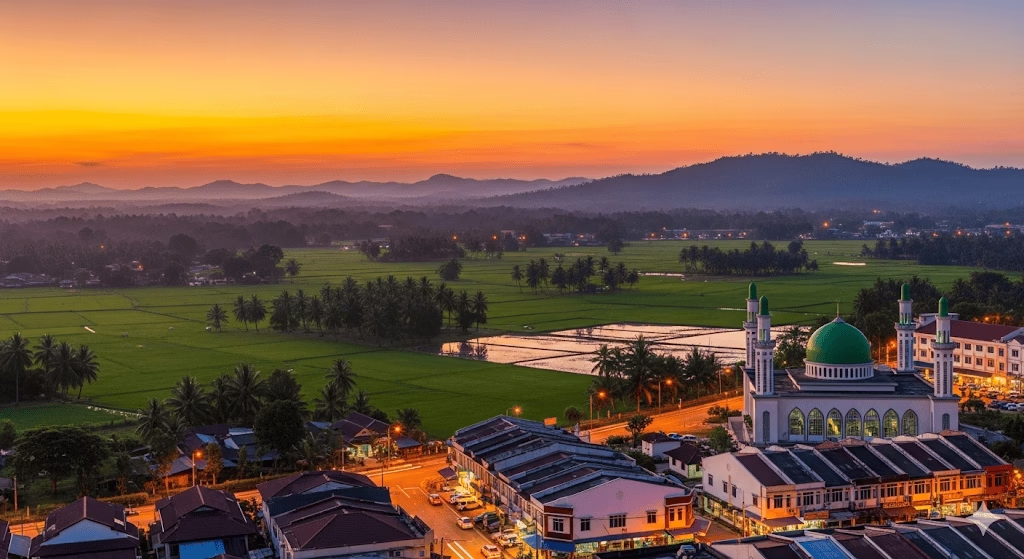Batu Caves Selangor Malaysia

Introduction
Batu Caves is one of Malaysia’s most iconic attractions, combining spiritual significance, natural beauty, and adventure activities. Located just 13 km from Kuala Lumpur, this monumental Hindu temple set inside a limestone hill draws over a million visitors annually, especially during the vibrant Thaipusam festival.
Etymology – Why is it Called Batu Caves?
The name “Batu Caves” comes from Sungai Batu (Stone River), which flows nearby, and Batu Village. In Malay, batu means stone, referencing the ancient limestone hill that houses the caves.
History of Batu Caves
The Batu Caves gained prominence in 1891 when K. Thamboosamy Pillai, an Indian Tamil trader, dedicated a shrine to Lord Murugan, the Hindu god of war. Since then, it has become the most important Hindu pilgrimage site in Malaysia, particularly for the Tamil community.
Geology – A 400-Million-Year-Old Wonder
The limestone hill of Batu Caves is estimated to be 400 million years old. Formed through natural erosion, it features large caverns, stunning stalactites and stalagmites, and unique rock formations. The main chamber, Temple Cave, is the largest and most visited.
Biodiversity at Batu Caves
Despite heavy tourism, Batu Caves supports a fragile ecosystem:
- Long-tailed macaques
- Fruit bats
- Over 200 plant and animal species
Some species are endemic to limestone ecosystems, highlighting the site’s ecological importance.
Religious Significance of Batu Caves
The Temple Cave
The central attraction, Temple Cave (also known as Cathedral Cave), is accessible via 272 colorful steps. Inside, you’ll find Hindu shrines and sculptures dedicated to Lord Murugan, set beneath a towering open ceiling.
Lord Murugan Statue
At the base of the stairs stands the world’s tallest Lord Murugan statue:
- Height: 42.7 meters (140 feet)
- Materials: 250 tons of steel, 300 liters of gold paint
- Built in: 2006 over a period of 3 years
Thaipusam Festival at Batu Caves
Thaipusam, held in January or February, is Batu Caves’ most significant annual celebration. Devotees perform spiritual acts like:
- Carrying kavadis (decorative offerings)
- Walking barefoot from Kuala Lumpur
- Fasting and enduring acts of penance
Over 1 million pilgrims visit Batu Caves during Thaipusam, making it one of Southeast Asia’s largest religious festivals.
Rock Climbing in Batu Caves
Batu Caves is also a popular rock climbing destination, with over 160 routes on its limestone cliffs. Top spots include:
- Damai Wall – Ideal for beginners
- Nyamuk Wall – Intermediate and challenging climbs
- White Wall – For advanced climbers seeking a thrill
Top Stay Near Batu Caves
Sunway Putra Hotel Kuala Lumpur
Located just a 20-minute train ride away, Sunway Putra Hotel offers upscale accommodation, direct mall access, and proximity to KTM Komuter for easy travel to Batu Caves. It’s perfect for tourists who want comfort, convenience, and cultural exploration in one package.
Other nearby options:
- Hilton Garden Inn KL North – Affordable and near Chow Kit.
- Mercure Selayang – Good mid-range stay near Gombak.
How to Get to Batu Caves
By Train (Best Option):
- Take the KTM Komuter (Batu Caves Line) from KL Sentral.
- Stop at Batu Caves Station—the caves are a 5-minute walk from the station.
By Bus:
- Board the RapidKL U6 bus from Titiwangsa Bus Terminal.
- It stops directly at Batu Caves.
By Car:
- 20–30 minutes drive from Kuala Lumpur city centre.
- Ample parking is available for RM2 per entry.
Attractions Around Batu Caves
- Temple Cave – Main site of worship, home to Hindu shrines.
- Lord Murugan Statue – Iconic and symbolic sculpture.
- Ramayana Cave – Mythical dioramas with vivid lighting.
- Cave Villa – Gardens, koi ponds, art displays, and dance performances.
- Dark Cave – Guided tours exploring Malaysia’s underground biodiversity.
- Bird-Feeding Spot – A small nature corner popular with families.
Top Food Point Near Batu Caves
Dhivya’s Café
Just outside the main entrance, Dhivya’s Café is a beloved spot among both pilgrims and tourists. They serve authentic South Indian meals, including banana leaf rice, thali sets, masala dosa, and spicy curries—all vegetarian and freshly made.
Other options:
- Rani Restaurant – Famous for its vegetarian banana leaf platters.
- Gomathi Vilas – A local favourite for breakfast dosas and chai.
Batu Caves Ticket Price (2025)
| Attraction | Adult Ticket | Child Ticket |
|---|---|---|
| Temple Cave | Free | Free |
| Ramayana Cave | RM5 | RM3 |
| Cave Villa (Gallery + Fish Pond) | RM15–RM20 | RM10–RM15 |
| Dark Cave Tour (if open) | RM35–RM45 | RM25–RM30 |
Note: Prices may vary. Some caves are temporarily closed due to conservation or safety.
Frequently Asked Questions (FAQ)
Q1: Is there a dress code at Batu Caves?
Yes. Visitors must wear modest clothing. Shoulders and knees should be covered. Sarongs are available at the entrance.
Q2: What’s the best time to visit Batu Caves?
Early morning (before 10 AM) or weekdays are ideal to avoid the heat and large crowds.
Q3: Is food available near Batu Caves?
Yes, several vegetarian Indian restaurants and food stalls are available outside the complex.
Q4: Are the 272 steps hard to climb?
They require moderate effort. Visitors can rest at intervals. Elderly or mobility-challenged visitors may struggle.
Q5: Can tourists visit during Thaipusam?
Absolutely! It’s a vibrant cultural experience, but be prepared for huge crowds and road closures.
Q6: Is Batu Caves wheelchair accessible?
Only the base area is accessible. The stairs leading to the Temple Cave are not wheelchair-friendly.
Final Thoughts
Batu Caves is more than just a religious site—it’s a vibrant mosaic of culture, heritage, nature, and devotion. With its stunning natural landscape, spiritual aura, and photogenic appeal, it continues to be a must-see destination whether you’re visiting Selangor, Kuala Lumpur, or anywhere in Malaysia.








Comments are closed.